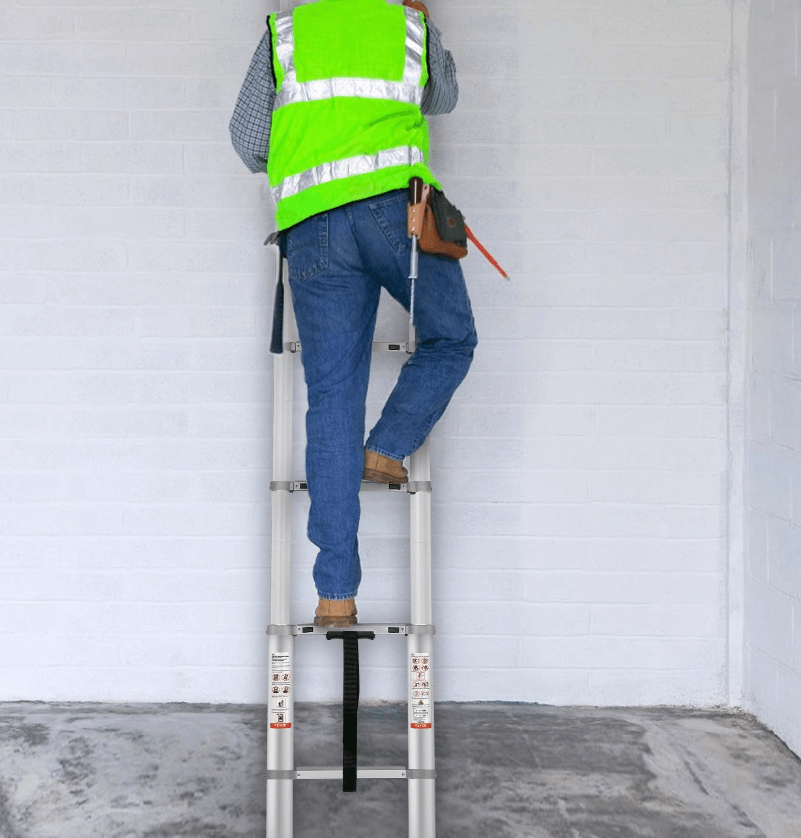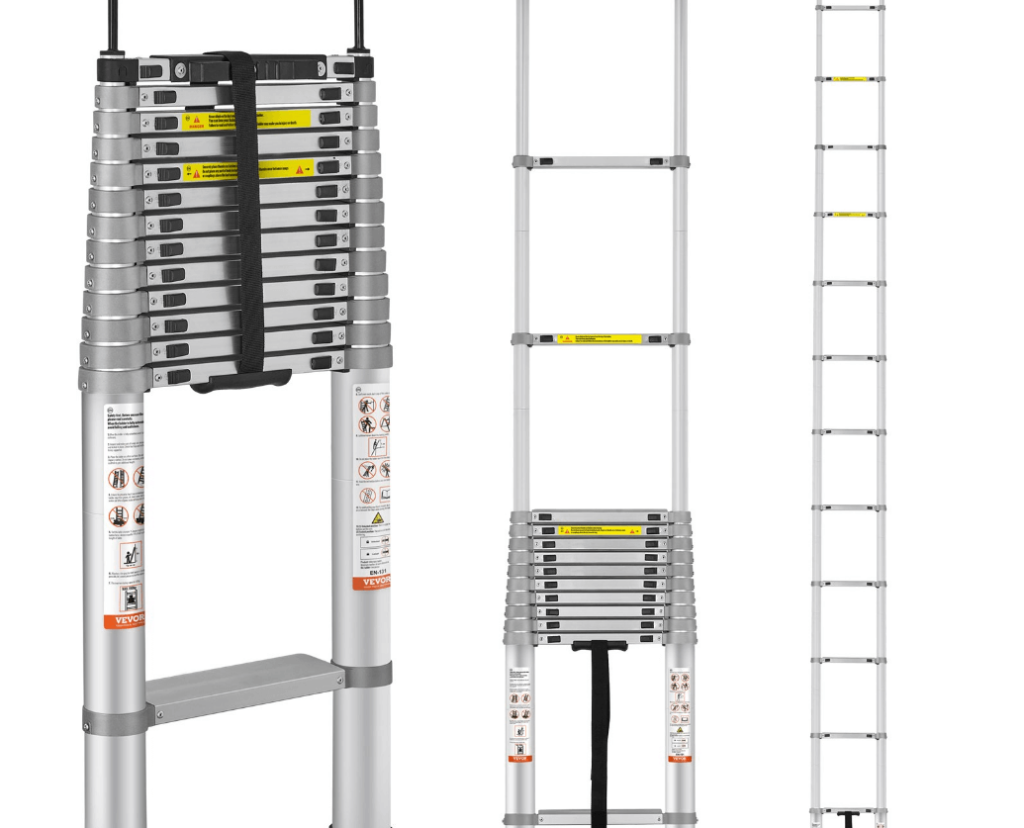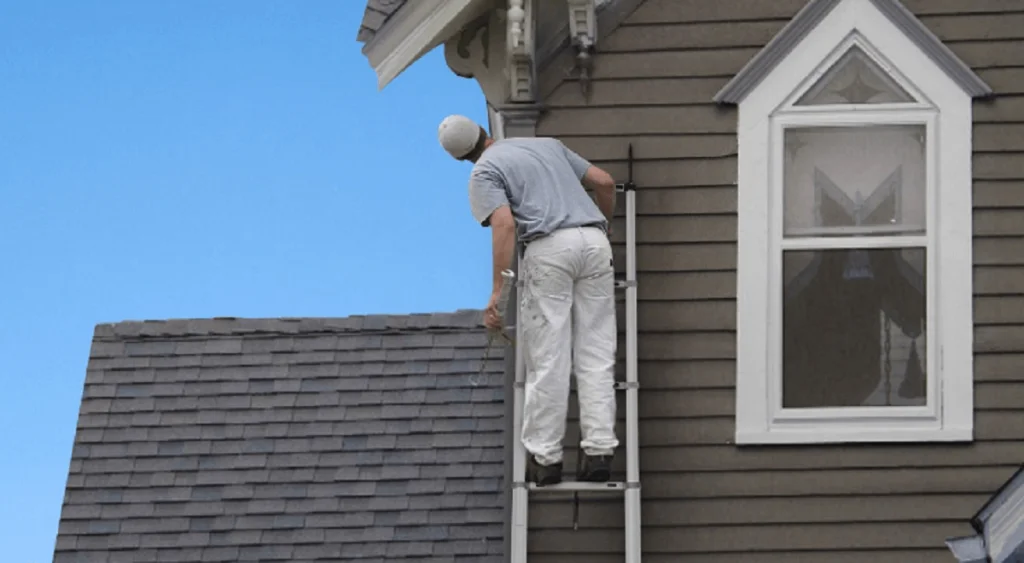Buying is not just exchanging money and goods but requires careful consideration. Gone are the days when handling tasks related to height was hectic. Things have changed, and the telescopic ladder is making things way easier.
It’s easy to use and adjustable.
But wait before you go and get one; there are a few things you’ll need to consider ensuring you pick the best telescoping ladder for your needs.
- What is the ladder’s material?
- How much weight can it support?
- What’s the maximum height?
Also, knowing exactly what you’ll use the ladder for can help you select the perfect model.
This guide will cover everything you need to know before finalizing your telescopic ladder.
Table of contents
- What is a Telescoping Ladder?
- Common Uses and Applications
- Benefits of Telescoping Ladders
- Types of Telescoping Ladders
- Key Features to Consider When Choosing a Telescoping Ladder
- Safety Tips for Using Telescoping Ladders
- Common Mistakes and How to Avoid Them
- VEVOR Telescoping Ladder
- Maintenance and Care
- Troubleshooting Common Issues
- Frequently Asked Questions
What is a Telescoping Ladder?
A telescoping ladder is a handy tool that can be extended or collapsed, making it easy to store and carry around. Imagine a ladder that can shrink to a small size, perfect for fitting in your car trunk or a tiny closet. These ladders are usually made from strong but lightweight materials, like aluminum or fiberglass. The ladder sections slide past each other to extend, retract, and lock securely to keep you safe while working.
Differences from Traditional Ladders
Are you still in a dilemma as to why you should choose a telescopic ladder over a telescopic one? So keep reading!
Flexible Heights
Traditional ladder = fixed-length
Telescopic ladder = adjustable length
The traditional ladder has a fixed length and is bulky. On the other hand, the telescopic ladder is adjustable. You can adjust the height according to the task.
Lightweight and Portable
You can only quickly move traditional ladders here slowly as they are heavy, while telescopic ladders are lightweight and easy to carry.
Common Uses and Applications
Telescoping ladders are handy and can be used for all kinds of tasks at home and on the job. Here are some common ways people use them:
- Home Maintenance
Clean gutters, paint walls, or change light bulbs.
- DIY Projects
Hang pictures, install shelves, or build furniture.
- Professional Trades
Electricians, plumbers, and contractors find them handy for job sites.
- Outdoor Activities
Trim trees, clean windows, or make exterior home repairs.
- Emergency Services
Firefighters and rescue teams appreciate their compact size during emergencies.
Benefits of Telescoping Ladders
Telescoping ladders are a great modern alternative to traditional extension ladders. They offer the following benefits:
Easy to Carry and Store
They are easy to carry and store. You can easily collapse them to a few feet long, making them easy to fit in your car trunk or carry. The telescopic ladder can also fit anywhere, whether in the closet or the garage if you have limited storage space.
Adjustable Height
Adjustable doesn’t mean adjusting it all together; you can adjust each section to your required height. Would you change a light bulb? Set it accordingly. Are you planning to paint a wall? Then, make a few adjustments, and you are ready.
Durable
Telescopic ladders are made from aluminum or fiberglass. These elements make them lightweight and robust. Aluminum is rust-resistant, while fiberglass doesn’t conduct electricity.
Safety Features
There is no chance of collapsing accidentally. Yes, you heard it right. It is safe and has non-slip feet, which makes it secure on the ground.
Types of Telescoping Ladders
There are several types of telescoping ladders available on the market today. Each type has unique features and benefits, suitable for different purposes and needs.
Single-Section Telescoping Ladders
Single-section telescoping ladders are straightforward to use. They have one extendable section and are perfect for tasks requiring extra height. These ladders are:
- Easy to transport and store
- Ideal for home maintenance tasks like:
- Changing light bulbs
- Reaching high shelves
- Doing light repairs
Multi-Section Telescoping Ladders
Multi-section telescoping ladders come with multiple expandable sections. This makes them more versatile and adjustable for different heights. They are handy for professionals who work at various heights. Key points include:
- Can be locked at different heights
- Suitable for a wide range of tasks
- Great for professional tradespeople
- Can be used fully extended or partially extended

Extension Telescoping Ladders
Extension telescoping ladders work like traditional extension ladders but can telescope back for more accessible storage. These ladders are suitable for tasks that need significant height. Features include:
- Can extend to heights of 20 feet or more
- Perfect for functions like:
- Roof repairs
- Tree trimming
- High-level painting
- Compact when retracted, making them easy to store and transport
Each telescoping ladder type offers unique benefits, making it useful for different situations and needs. Please choose the one that best suits your tasks and enjoy its convenience and versatility.
Comparison of Different Types
| Type | Description | Best For | Advantages | Limitations |
| Single-Section Telescoping Ladders | One continuous extendable section | Simple tasks requiring moderate height | Easy to use, transport, and store | Limited height adjustment |
| Multi-Section Telescoping Ladders | Multiple extendable sections that lock at various heights | Tasks requiring varying heights, professional use | Greater flexibility, adjustable to different lengths | More complex to operate |
| Extension Telescoping Ladders | Functions like a traditional extension ladder with telescoping capabilities | High-reaching tasks (e.g., roof repairs, tree trimming) | Highest reach, compact when retracted | Heavier, may require more space when fully extended |
Key Features to Consider When Choosing a Telescoping Ladder
Here are some key features to consider:
Material Matters
Aluminum
- Aluminum ladders are lightweight and rust-resistant, making them easy to carry and move around. They’re an excellent choice for regular use because of their durability.
Fiberglass
- A fiberglass ladder is your best bet if you’re doing electrical work. These ladders don’t conduct electricity and are incredibly stable and weather-resistant. However, they are heavier than aluminum.
Other Materials
- Some ladders incorporate a mix of different materials or include plastic parts for added comfort and flexibility. Think about your specific needs and how you’ll use the ladder before choosing.
Think About Height and Weight
Maximum Height
- Consider how high you need to reach for your tasks. Whether indoor home repairs or professional jobs, ensure the ladder’s height meets your needs.
Weight Capacity
- Check the ladder’s weight capacity, which ranges from 250 to 330 pounds. Ensure it supports your weight and the tools and materials you’ll carry.
Safety First
Locking Systems
- Look for a ladder with reliable locking systems that keep the sections from collapsing accidentally. Solid locks that are easy to engage and secure each section firmly are a must.
Anti-Pinch Features
- Protect your fingers with ladders that include anti-pinch features, making it safer and more comfortable to extend or retract the ladder.
Indicators
- Some ladders come with indicators that show when each section is securely locked, adding an extra layer of safety.
Ease of Use
Extension and Retraction Mechanism
- It is crucial to have a smooth and easy-to-operate mechanism for extending and retracting the ladder. Choose a ladder that allows you to adjust the height without hassle.
One-Button Retraction
- Some ladders feature a one-button retraction system, making it simple to collapse the ladder quickly and safely.
Portability
Weight
- Opt for a lighter ladder if you need to transport it frequently. It will be easier to carry and move around.
Carrying Handle
- A built-in handle or carrying straps can make moving the ladder from one place to another much more convenient.
Stability and Non-Slip Feet
Non-Slip Feet
- Ensure the ladder has non-slip feet to stabilize and prevent slipping on various surfaces. Rubberized or textured feet work best.
Base Stability
- A broader base will make the ladder more stable and less likely to tip over. Ensure the base design suits the surfaces you’ll be using it on.
Rung Design
- Look for angled or ridged rungs that provide better footing and reduce the risk of slipping while climbing or standing.
Recommended For Your Project
Safety Tips for Using Telescoping Ladders
Telescoping ladders are convenient and versatile for many tasks, from reaching high shelves to completing construction projects. However, they do come with their own set of safety risks that should not be taken lightly.
Proper Setup and Inspection Before Use
Before using a telescoping ladder
- Take a moment to check it over.
- Look for any damage, like cracks or bends.
- Ensure all the locking parts work well and the rungs are clean.
- Set up your ladder on a flat, stable surface to avoid tipping. If you’re using it outdoors, ensure the ground is firm and not slippery.
Correct Angle and Positioning
Getting the angle right is crucial for safety. Aim for about 75 degrees. A simple way to do this is by placing the base of the ladder one foot away from the wall for every four feet of ladder height. Also, ensure the ladder’s feet are planted firmly, fully extended, and locked before climbing.
Weight Distribution and Load Limits
Stick to the weight limits given by the manufacturer. Overloading can cause the ladder to collapse or become shaky. Distribute your weight evenly as you climb, and avoid leaning too much to one side. Use a tool belt or pouch to carry tools, keeping your hands free for balance.
Common Mistakes and How to Avoid Them
- Skipping Inspections: Always inspect the ladder before use to catch any potential problems.
- Incorrect Setup: Ensure the ladder is fully extended, locked, and placed at the proper angle.
- Overreaching: Keep your body centered and avoid leaning too far to the sides.
- Ignoring Weight Limits: Stick to the maximum weight capacity to prevent accidents.
- Improper Storage: Store the ladder in a dry, safe place to avoid damage and increase lifespan.
Following these simple tips, you can use your telescoping ladder safely and effectively.
VEVOR Telescoping Ladder

The VEVOR telescoping ladder is a versatile and sturdy option for professional and home use. Made from high-quality aluminum alloy, it’s lightweight yet durable. The ladder extends to various heights and includes safety features like locking mechanisms and non-slip feet.
Key Features
- Superior Load Capacity: Crafted from aviation-grade aluminum alloy with a maximum load capacity of 375 lbs (170 kg).
- Stability You Can Trust: Durable step interfaces, non-slip top cover, and bottom feet cover for added stability.
- Easy to Carry & Store: Lightweight and portable. Fits under the sofa, behind doors, or in a car trunk.
- One Button Retraction: Easily retract the ladder with a thumb button, ensuring smooth and safe operation.
- Versatile Use: Ideal for home repairs, decoration, wall painting, bulb changing, tree pruning, RV ladder, etc.
Pros
- Lightweight and portable
- Easy to extend and retract
- Secure locking mechanisms
- Non-slip feet for added stability
- Competitive Pricing
Cons
- Heavier compared to some competitors.
- Locking mechanisms can sometimes be stiff.
- Limited maximum height compared to traditional extension ladders
Price Range and Value for Money
The VEVOR telescoping ladder typically ranges from $90 to $150, depending on the model and maximum height. Considering its features and build quality, it offers good value for money, especially for those seeking a reliable and portable ladder for various tasks.
Maintenance and Care
Regular Inspection and Cleaning
- Inspect the ladder regularly for any signs of wear or damage.
- Clean the ladder after each use to remove dirt, debris, and moisture, which can cause corrosion or affect the locking mechanisms.
Lubrication and Parts Replacement
- Lubricate moving parts and locking mechanisms periodically for smooth operation.
- Replace worn or damaged parts immediately to maintain safety and functionality.
Storage Tips to Prolong Lifespan
- Store the ladder in a cool, dry place away from direct sunlight and extreme temperatures.
- Avoid storing the ladder in a collapsed state for prolonged periods to prevent stress on the locking mechanisms.
Troubleshooting Common Issues
- Stiff Locking Mechanisms: Lubricate the locks to improve functionality.
- Difficulty Extending or Retracting: Ensure the ladder is clean and debris-free. Lubricate the joints if necessary.
- Wobbly Feet: Check and tighten any loose screws or bolts, and replace non-slip feet if worn.
Frequently Asked Questions
How to Choose the Right Height?
Consider the highest point you need to reach when picking out a ladder. To keep things safe and comfy, go for a ladder extending beyond that point. This way, you will be stretching less or feeling unsteady.
Are Telescoping Ladders Safe?
Absolutely! Telescoping ladders are super safe when you use them right. Just make sure it’s fully extended and locked before you climb up. And always stick to the weight limits to avoid any accidents.
How Do I Maintain My Telescoping Ladder?
Keeping your telescoping ladder in good shape is a breeze. Regularly check and clean it, lubricate the moving parts, and store it in a dry, safe spot. If you see any damaged parts, replace them immediately to keep everything working smoothly.
Can Telescoping Ladders Be Repaired?
Yes, they can! Most parts, like locks, rungs, and non-slip feet, can be replaced. If something breaks, you don’t always have to buy a new ladder—fix the faulty part.
Last Line
Telescoping ladders are incredibly convenient and versatile for various tasks. When choosing one, consider key features like material, height, weight capacity, and safety mechanisms. Regular maintenance and proper use will ensure your ladder lasts long and stays safe. The VEVOR telescoping ladder stands out for its value and reliability, making it an excellent choice for home and professional use.
Give the VEVOR telescoping ladder a look for a dependable and versatile ladder. Visit VEVOR’s website to check out their range of telescoping ladders and find the perfect model for your needs.





